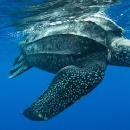Seasons of Wildlife
Marine Mammals
The Monument is exceptional for its diversity and abundance of marine mammals, including at least 10 dolphin species, seven large whale species, and six medium whale species. There are several species that are very rare, including the endangered sperm whale, sei whale, and fin whale. The Monument is also home to three species of beaked whales, which are known to be some of the best divers on the planet, with a recorded maximum dive depth of almost two miles (9,000 feet) in the submarine canyons!
During aerial surveys, researchers have observed several marine mammals feeding, some accompanied by calves, indicating that this area is likely important as feeding and nursery habitat for many species of whales and dolphins. Marine mammal migration has also been noted to occur through the Monument. Researchers consider the Monument area to be a marine mammal hotspot.
Deep-Sea Corals
The Monument is exceptional for its diversity and abundance of deep-sea corals (also known as cold-water corals). Deep-sea corals grow in deep, cold water, where there is no sunlight. Unlike tropical corals that have photosynthetic algae to supplement their diet and facilitate their growth, deep-sea corals lack this assistance and consequently grow extremely slow. The deep-sea corals within the Monument have many associated species, including sponges and anemones which together form the foundation of deep-sea ecosystems. These ecosystems provide food, shelter from predators, breeding, spawning, and nursery habitat. Between 2003 and 2014 during Okeanos ROV deep-sea dives conducted by NOAA, at least 58 species of coral were identified in the Monument, including several newly discovered species.
Fishes
Because of the complex topography and oceanography within the Monument, and the resulting high food production, there is a rich diversity of fishes. Scientists consider the Monument a biodiversity hotspot for deep-sea fishes.
In a 2003 study, 591 fish species were found living below 650 feet in the New England shelf region of the Monument. Expeditions to Bear Seamount found several rare fish species that were previously unknown to occur in this area of the Atlantic Ocean. The canyons are home to various species of flounders, hake, skates, ocean pout, cusk, grenadiers, and eel; some of which occur in dense aggregations.
Larger pelagic fish like swordfish, tuna, and sharks also use the Monument. In fact, many shark species rely on the coral ecosystems found within the Monument for the beginning of their life cycle, with egg cases being deposited on the corals.
Seabirds
Marine birds are known to concentrate in upwelling areas of the Monument, largely around the canyons. These areas have high productivity and subsequent food availability, resulting in large concentrations of birds. Several species of gulls, shearwaters, storm petrels, gannets, skuas, and terns, among others, regularly occur here in large aggregations. Researchers have recently discovered that Atlantic puffins are overwintering here because of the abundant food. Prior to 2015, no one knew where these charismatic birds spent their winter months!
Sea Turtles
Four species of protected sea turtles forage in the Monument: Kemp’s Ridley, leatherback, loggerhead, and green sea turtles. These species tend to follow the Gulf Stream as they look for food during their long migrations. The leatherback sea turtle is an incredible diver and has been known to dive to depths up to 4,000 feet in search of jellyfish – their favorite snack!
Featured Species
The Monument is know for its abundance of marine mammals, deep-sea corals, rich diversity of fishes, turtles, and seabirds.









